What Are You Working On?
A thread to show us or ask us about whatever bonsai project you're currently working on.
Comments (50)
tapla (mid-Michigan, USDA z5b-6a)
Original Author2 years agoThe 4 books in my library that (IMO) will yield the most useful knowledge for beginners, in no particular order are:
"Botany for Bonsai" ~ Enrique Castano de la Serna
"Bonsai - It's Art, Science, History, and Philosophy" ~ Deborah Koreshoff (out of print - buy used) has great line drawings
"Bonsai" out of print - a Sunset book - ISBN0-376-03046-1 - buy used, great overview
"Bonsai Techniques I and Bonsai Techniques II" ~ John Naka (out of print - buy new [if you can find] or used) great for design inspiration
Al
Related Discussions
What are you working on?
Q
Comments (103)Yea !! I found my Annies Attic Mile a minute instructions I'm tired of making hats and misc granny squares for later use. I can get busy on one of these...See MoreWhat are you working on Oct 2010!
Q
Comments (12)Babka! That's beautiful! Thank you for the pictures. I know what you mean about the ends. In crochet, I usually work over the ends, then trim them. In knit, it's much harder to do that, but I try to weave most of them in as I go with a needle. Tami....who's glad to see some activity on the knitting board!...See MoreWhat are you working on now?
Q
Comments (10)I made some totems, birdbaths,and pf's for a spot to share at county fair-last minute she didn't have room left for my things...so I had to make room to store them. I got some shelves from my job (part time at gift shop that down-sized). So I installed shelves for glass on one wall and other crafts on adjoining wall. Glued more glass.Worked in yard and house...cleaning.Raining now, so I'm sewing owl little pillows. Also sewing towels to potholder to hang on oven handle. I made a USC planter chair, also a Clemson one...but no where to sell them--the gift shop has no room. I can bring a couple little things(owner gets 25%). I did get an application for artist consignment, but $100 to join and $50 space or $100 monthly space. I did sell my little car so I can buy a used truck-trying to commit to making my crafts a profitable business...I don't think "business" as much as "creative"...praying about it!...See MoreWhat are you working on?
Q
Comments (19)Panda Baby Afghan done using requested colors. The panda is worked from a grid. The bow-tie can be made any color (except white/black or the main color). I've made quite a few of these over the years. I only use the panda panel pattern, then create my own edging each time because I don't care for the printed pattern's edging. For this baby afghan I used popcorns to frame the panel and then added another set as I finished the edging. The finised size is larger than I'd normally make a baby afghan, again by request. The finished size is about 32" x 50". A few close-up below:...See Morejasmine UKzone9a
2 years agoI am trying to keep my jasmin sambac and orange jasmine(Murraya paniculata) small. but I am not sure if I can bonsai them ( if they react well as bonsai ). here are photos of them.
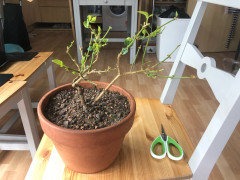
the above is jasmine sambac maid of orleans.
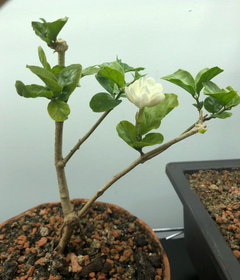
the above is sambac mysore mulli
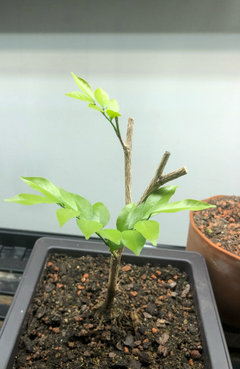
orange jasmine, I have no clue what shape/design I want for this tree.
jasmine UKzone9a
2 years agoI also have a ginkgo bonsai. that's what it looks like. if I keep those grass and little plant on the soil surface. will they weaken my ginkgo?
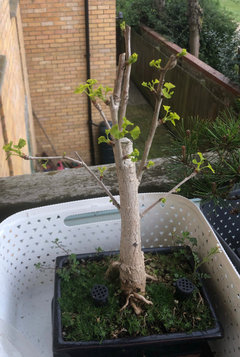
tapla (mid-Michigan, USDA z5b-6a)
Original Author2 years agoAlmost any tree/shrub can be treated as a bonsai, but not all trees are well suited as bonsai candidates. The best candidates for budding bonsai artists are those with natural genetic vigor and have small leaves or leaves that readily reduce in size as the tree ages and the artist exercises leaf reduction techniques after the trunk is appropriately thickened to a caliper reasonably proportional to the expected height of the tree. Once you become practiced in the art, you'll use MANY of the techniques you'll learn to help you get more enjoyment from your interaction with plants.
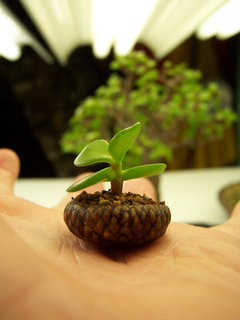
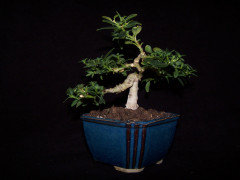
Guess what I am ^^^
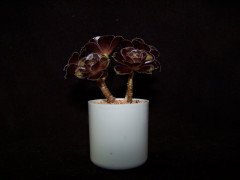
Aeonium in a Chapstick cap ^^^
"I have no clue what shape/design I want for this tree." Your tree will eventually tell you what it wants to be. As you progress, you'll learn to look for the tree in the tree, which is essentially sorting through the branches looking for a trunk line that looks natural, or better, evocative. Much about bonsai centers on the quest to make others feel something when they view your trees. The tree should tell a story ...... but that comes with time.
If you know you're hooked on the art, I strongly suggest you buy some very small trees, hardy where you live, and get them into the ground so you'll have older material to help hone your skills.
Weeds compete with the tree for water/ nutrients and their roots compete for soil oxygen and reduce gas exchange. Keep any real moss to a minimum, and do not allow moss to grow on the top of roots or on the trunk. All weeds should be removed as soon as they appear so they have no chance of seeding out. Especially noxious is the Sabina subulata (aka pearlwort or Irish moss) growing over the soil surface of the ginko. I thought it was pretty too when I first started into bonsai, but it will eventually become so compacted, watering will be difficult and it will suck the life right out of the plant. It took me years to clear that monstrous stuff out of all my pots and raised beds. Pull every single plant with a good pair of tweezers and never buy a plant with pearlwort growing in it's pot. If you keep it, you'll have it in all your pots, even if they are 50 ft apart.
Al
jasmine UKzone9a
2 years agoginkgo bonsai with weed
I remove all the weeds but that expose a lot tree roots either. do you think if I should top up with some soil or mulch or maybe repot it now, I am not sure if it's a good time though? here are some photos I took today.
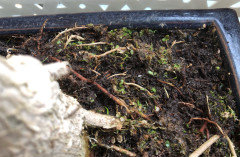
see the soil above. do you think it's weird this tree can survived in soil without any grits? I bought this tree at last year at autumn. I am not sure what kind of soil does it grow in before. when I repot it next time. what kind of soil mix will you recommend?
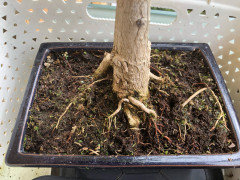
the above shows a lot root exposed after I remove all the weed. I don't know if that will be a problem.
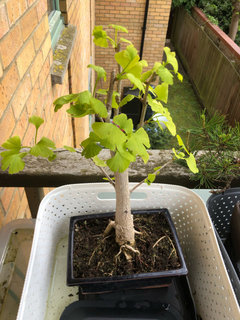
that's how my tree looks
succulent bonsai
the first succulent tree you have is so cute. what does it grow on? it looks like an upside down shiitake mushroom pot. so cute! the second one looks like a jade plant? how long have you grow succulent as bonsai?
about keep plant small. do you know if I can keep a magnolia. alba (white champaca) small and grow it indoor? as well as osmanthus fragrans?tapla (mid-Michigan, USDA z5b-6a)
Original Author2 years ago"I remove all the weeds but that expose a lot tree roots either. do you think if I should top up with some soil or mulch or maybe repot it now, I am not sure if it's a good time though? here are some photos I took today." The weeds will be back and I encourage you to stay after them until there isn't a single pearlwort within shouting distance.
That the roots are exposed is no problem if you keep them out of full sun until they've hardened off a bit. If you put the tree in full sun, the roots will get sunburned (photo-oxidation) and the exposed part (top half) of the root will die.
The plant definitely needs to be out of that medium, but you should only repot when it's dormant - just before the spring push would be best. If the tree was a little healthier, you could defoliate it and repot, but I wouldn't feel comfortable advising you to do so.
After you water, allow the pot to drain after securing it so the pot bottom is tipped 45* from horizontal. In the first image in your post above, I can see water glistening at the surface. That means you stopped watering to take the picture, or the soil supports a PWT (perched water table) that is higher than the soil is deep. That's a bad set-up, but you'll likely need to limp through with it until next spring. Compare B to A in the image below to see how much difference tipping the pot makes insofar as water retention is concerned. The pots are full of grow medium and the shaded part represents medium 100% saturated with water. Also, after the pot stops draining in the tilted position, hold the pot in that position and move it downward over the sink, then sharply reverse the direction to upward. You'll immediately note that a good measure of 'excess' water will “continue downward in a straight line” and exit the drain hole. That's Newton's First Law of Motion at work. The sharper the reversal of direction, the more water exits the drain hole. When you have repeated the exercise until water no longer exits the drain hole on the reversal of direction, you will have eliminated all excess water and your plants will regard you with a newfound sense of awe.
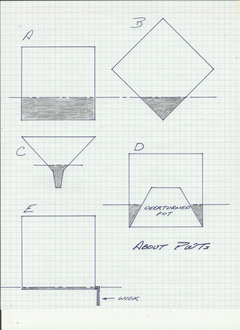
"Do you think it's weird this tree can survive in soil without any grits?" Not really. Young trees are nearly all dynamic mass, which translates to a strong "will to live". The tree is definitely not liking the home provided for its roots, but there's not much to be done about it. You could try to work some perlite down into the soil with a chopstick or wood skewer, but I think if you follow the previous instructions re how to remove excess water, you can make it until next spring. Where do you live? If you can protect the roots from freezing temps and still give the tree its essential cold dormancy, you could repot in fall. Make sure you don't water unless/until the tree actually needs it. As things stand now, the grow medium and the excess water it holds are your worst enemy.
"The first succulent tree you have is so cute. what does it grow on? it looks like an upside down shiitake mushroom pot. so cute! the second one looks like a jade plant? how long have you grow succulent as bonsai?" The first image is Portulacaria growing in a white oak acorn cap. The grow medium is fine Turface screenings. The second image is a snapdragon, and the third image is Aeonium arboreum 'Zwartkop' in a cap from a tube of Chapstick.
I don't consider these plants as bonsai; rather, I grow them for their novelty and as companion plants to bonsai on display. I enjoy propagating them and giving them away to people I enjoy meeting in my daily travels.
Al
jasmine UKzone9a
2 years agoThe plant definitely needs to be out of that medium, but you should only repot when it's dormant - just before the spring push would be best.
when will be before the spring push? when I see green leaf start growing?
Make sure you don't water unless/until the tree actually needs it. As things stand now, the grow medium and the excess water it holds are your worst enemy.
I think this bonsai tree stay wet from the time I bought it last. year at fall. I live near london. the winter temperature can get down to -3C quite often(half of winter) . but rarely get lower than -5C. I grow my bonsai at balcony. so I am not worried about full sun. but raining can be a problem. it rains almost every day currently. rainfall here is about 27 inches per year. maybe I can push in some crush lava rock and try not to repot it unless it shown sign of rotting?
jojosplants2020
2 years agoAl,
Would Fairy Duster Bush be a good starter plant ?
https://www.horticultureunlimited.com/plant-guide/baja-fairy-duster/tapla (mid-Michigan, USDA z5b-6a)
Original Author2 years agoWhen will be before the spring push? when I see green leaf start growing? Keep an eye on the buds. When soil temps rise to above 45F/7.2C for a week or so, the buds will begin to swell. Just as that occurs is a good time to repot. If you can see leaves emerging, you've waited too long but you can still repot, but will need to be careful of how much of the root system you repot. I expect you won't want to remove much of the root system at the first repot unless the tree responds well to the new treatment.
The winter temperature can get down to -3C quite often (half of winter), but rarely get lower than -5C. I grow my bonsai at balcony, so I am not worried about full sun, but raining can be a problem. It rains almost every day currently. Rainfall here is about 27 inches per year. The plant is quite cold tolerant, so it should handle the winter temps on the balcony, but you'll need to cover it to keep the rain out during winter and water it occasionally. The cover should be opaque - a wooden box would be ideal. Maybe I can push in some crush lava rock and try not to repot it unless it shown sign of rotting? You could try depotting it, setting the roots on a flat surface and gently teasing the soil off the roots, or use a mist setting to spray it off. You could also hold the trunk and swish the roots in a tub of water; then, w/o trimming the roots, repot it in a terra cotta pot using bonsai soil. Adding a rayon wick would be helpful. If you don't prune the roots, chances are about 2:1 the plant will make it. It sounds like all the rain you expect is going to be a problem unless you have a plan to deal with it.
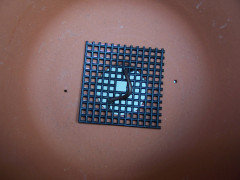
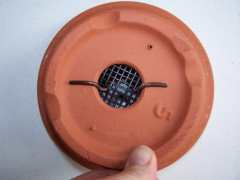
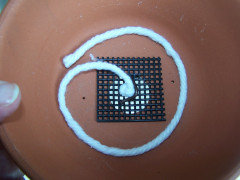
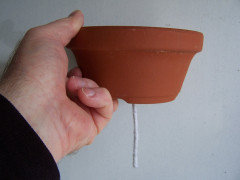
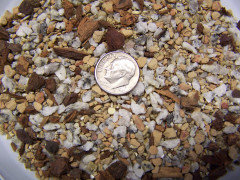
Al
tapla (mid-Michigan, USDA z5b-6a)
Original Author2 years agoWould Fairy Duster Bush be a good starter plant? Calliandra make interesting bonsai if you have the required patience to wait until the trunk thickens (meaning they resist thickening so they look more proportional (fat at the lower trunk with a gradual taper towart the apex) and don't have to worry about frost where you live.
Al
tapla (mid-Michigan, USDA z5b-6a)
Original Author2 years agoAfter the really warm week we've had, today at 55* and a stiff breeze made it seem like winter's back.
What I worked on today:
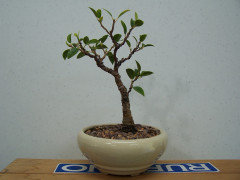
A very young Ficus microcarpa, second time wired
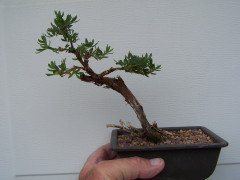
Potentilla fruticosa, pruned only
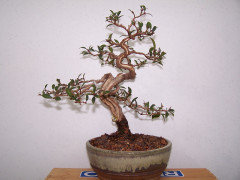
Eugenia (brush cherry) pruned hard (removed about 90% of the foliage) and repotted.
Al
jojosplants2020
2 years agoBrrr...!! Our low was 66! lol.. Were going to hit 100 tomorrow here in Tucson, Az.
Your tree's look amazing! I love the last one!
I think I will pass on the Fairy Duster for now.Any suggestions for a beginner project for zone 9b?
Jo Jo
jasmine UKzone9a
2 years agoI expect you won't want to remove much of the root system at the first repot unless the tree responds well to the new treatment.
it seems there are quit a lot of root in pot already. I didn't cut any of them though. but I wonder if I should cut some of them at spring next year. photo below shows how the roots looks. it seems there are a lot thick root. should I cut all the thick root and let it grow hair thin root?
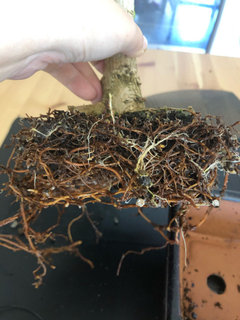
I also manage to remove some soil. but I did it gentle to avoid breaking too much root. after remove some soil. I add some akadama(60%) lava rock (40%) mix at the boom of the pot. do you think this mix will be ok?
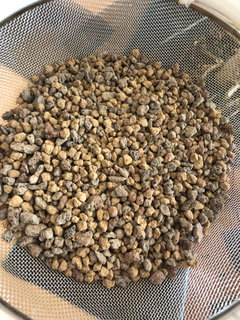
and that's how the tree looks in pot. I had add soil mix to the bottom. do you think if I should leave it like this?
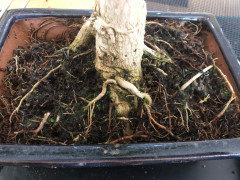
tapla (mid-Michigan, USDA z5b-6a)
Original Author2 years agoI wonder if I should cut some of them at spring next year. photo below shows how the roots looks. it seems there are a lot thick root. should I cut all the thick root and let it grow hair thin root? Yes, you should do a full repot next spring, assuming the tree has regained enough vitality to tolerate the repot. I can't see any reason it shouldn't. When removing thick roots, remember that those attached to the base of the tree should be kept as part of the future nebari unless they are problem roots - overlapping/crossing, growing straight down, ..... .
I add some akadama (60%) lava rock (40%) mix at the boom of the pot. do you think this mix will be ok? It looks rather coarse, but akadama breaks down with time, which increases water retention. Make sure to stay on top of the plant's watering needs for the summer.
I had add soil mix to the bottom. Do you think if I should leave it like this? No. It would be better if you poured soil over the roots and gently used a chopstick to work the particles into what are now the surface roots. If you don't, you'll need to shade them with a towel or piece of screen to prevent sunburn, or you could cover them with shredded sphagnum moss (not peat).
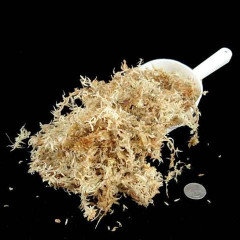
Al
tapla (mid-Michigan, USDA z5b-6a)
Original Author2 years agolast modified: 2 years agoHere's what kept me busy over the last week, along with LOTS of repotting tropical trees.
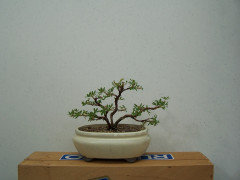
A young start of Potentilla fruticosa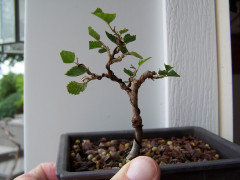
First partial wiring of a very young Carpinus coreana (Korean hornbeam)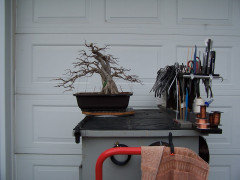
Ficus benjamina defoliated and wired 6/22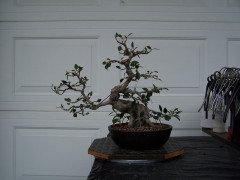
Ficus microcarpa, heavily defoliated and wired 6/22. The cuttings surrounding the tree are already rooted and will be approach-grafted to the trunk as additional prop roots. The thicker ones were grafted several years prior.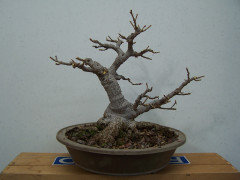
Ficus salicifolia/ nerifolia (willow-leaf/ narrow-leaf ficus) fully defoliated and wired 6/21Al
- tapla (mid-Michigan, USDA z5b-6a) thanked jasmine UKzone9a
tapla (mid-Michigan, USDA z5b-6a)
Original Author2 years agoIn case you feel inspired to try Potentilla as a bonsai subject, knowing a few things in advance will save you some frustration. 1) Most important is that the only species of Potentilla suitable as a bonsai subject is Potentilla fruticosa. All other species grow many, many trunks from basal sprouts, such that you'd need to pull the grow medium away from the roots and snip/ rub off the new shoots on almost a daily basis. Fruticosa still has some of that tendency, but is very easy compared to plants in the rest of the genus. 2) The plant doesn't like wet feet, but it requires lots of water (like potatoes and blueberries). For that reason, it likes a coarse medium with few to no fine particles and frequent watering. It shouldn't be allowed to dry down completely because there is a real risk of losing the plant. Fortunately, it signals it's need for watering by wilting. If you see the beginning of wilt, act quickly to irrigate. Plants in small bonsai pots often require watering twice per day. 3) It comes easily from cuttings. If you start it from a cutting, pick a small branch (twice as thick as a toothpick) that already has some movement in it. It tends to shoot out long and straight growth (like citrus), which lignifies (gets woody/ stiff/ brittle) quickly, so wire while branches are young and green. 4) It does best in full sun, but the pot should be shaded when temps rise above 85-90*.
Al
John (Zone 5b/6a, IN)
2 years agoI've been getting around to scratching the itch to try bonsai and I was wondering what basic advice you may be able to offer regarding the below, Portulacaria afra, as a candidate.
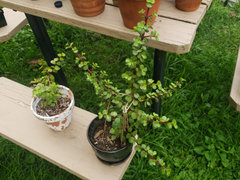
The one on the right
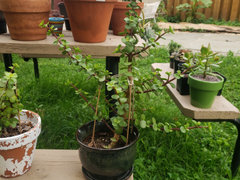
I've just let it grow for the past two seasons as it was the first plant I had and was the one that got me into growing in containers more seriously. I live in zone 5b/6a and I know it's not an ideal time of the year to repot for many common bonsai candidates so I was mostly planning on overwintering it inside and spending the time coming up with an idea of what to do with it. It's not in ideal bonsai soil (I honestly cannot remember what I threw together when I was just getting started, but it's nothing like the gritty mix I usually use now).
I was reading a blog by a bonsai practitioner in Florida, Adam Lavigne, the other day and saw two photos of P. afras grown by Richard Turner back sometime around 2013-2014 that blew me away. One thing that Adam mentioned was that Richard and another grower, Jim Smith, regularly tossed a handful of time release fertilizer on the soil surface; what are your opinions/personal preference when it comes to using time release fertilizer vs. liquid FP 9-3-6?tapla (mid-Michigan, USDA z5b-6a)
Original Author2 years agoI was wondering what basic advice you may be able to offer regarding the .... Portulacaria afra, as a candidate. First, if you get after it, you can still repot the P afra. Then, there is usually a difference in perspectives between what those just beginning their foray into bonsai and someone whose journey is already decades long. The beginner normally wants a bonsai, and they want it now; whereas the more experienced grower is going to urge you to start your journey with the idea you want to create something that evokes feeling in those who view your tree(s). While the ability to do that almost always comes with practice, there is no reason not to set yourself up now for what will come later.
So, I would start thinking about whether you want the tree to be formal, as in the straight trunk below (a formal upright tree I'm rebuilding the top on because the branching at the top became too heavy/thick),
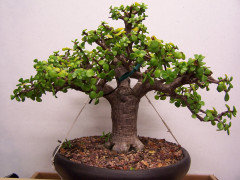
or, do you want an informal tree where the shape is more like an S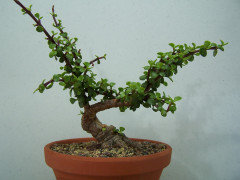
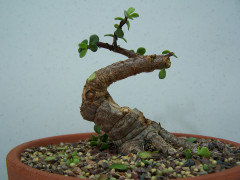
Trunks that taper from a heavy base to a much thinner top help significantly to add to the illusion of great age. This tree could go on to be an informal upright (has curves), or, the tiny stub of a branch on the right can be grown downward below the rim of the pot so the tree becomes a cascade style. You can decide what style you like now and work toward making your vision manifest in the tree, or you can continue to grow it out until it reveals to you what it wants to be when it grows up. In any case, thickening the trunk while planning for good taper is the best starting point.
I would make the first branch (from the soil line) on the left the new trunkline. So eventually, all the mass above where that first branch attaches to the trunk will go away. You only allow that mass to remain on the plant for now because it will continue to thicken the trunk below that first low left branch.
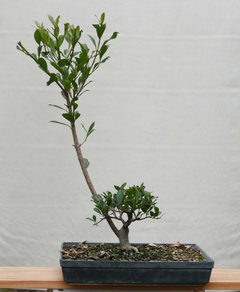
Sacrifice branch on a Ficus natalensis ^^^. Notice how I've removed foliage from the low part of the sacrifice branch so it can't shade the future tree. If you decide to use my suggestion, you should do the same.
If you want a cascade/ semi-cascade style, that would be easy, too.
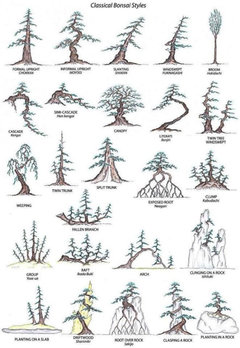
I'll pause until we know what direction you'd like to take.
Al
jasmine UKzone9a
2 years agothese are the "bonsai" collection I am working on. they are on my 40cm by 45cm table. the one I love the most is the lepanthes telipogoniflora between the chairs. it grows a lot leaves and flower well. the one on the left hand side of entrance is also a lepanthes as well. the small plant on right hand side of the entrance is a moss bonsai. I have never had moss bonsai. I am not sure how to keep it in small size. maybe just keep cutting its edge to keep it small. the big "trees" on both side are two type of asparagus fern. they looks like mini pine tree or bamboo to me. I tried to cut the left side asparagus fern in a nicer shape but it seems it's difficult to make a good shape out of it. no matter how I cut it. I still can't find a suitable shape.
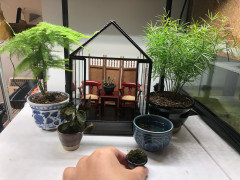
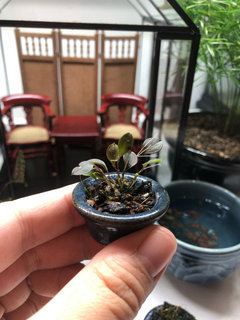
jasmine UKzone9a
2 years agohi Al, my ginkgo leaves looks a bit odd. is it normal? the leaves has a lot yellow dots. the nearby plants also has a lot little spot on leaves like that. also, the ginkgo leaves looks a bit dry and wrinkle like a folding kongfu fan. I wonder if that's normal. what do you think? it has been very windy and rain a lot this month.
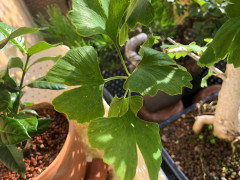
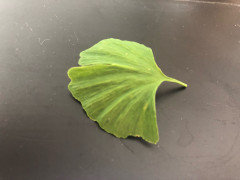
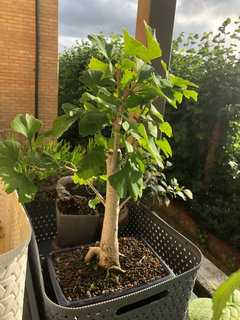
John (Zone 5b/6a, IN)
2 years agoThank you for the response! I have no issue repotting it, I just felt it might not be the best use of my time as opposed to just letting it continue to grow as it doesn't seem distressed or in dire need of a repot. I'm not sure what I would repot it into - would it be more proactive to move it into a more bonsai style pot or would it not matter at this point. Basically could I pot it into a standard black plastic nursery pot? Does it matter too much?
Jumping a bit ahead, the styles that draw my eye are the informal upright and the Literati. I've never seen a graphic depicting these different styles, this is so cool! Sekijo (I just did a quick image search) looks unreal! Right, back to your comments, if I were to go ahead with your recommendation and chop all of the mass above the lowest branch on the left (that is what you suggested, correct?) do I need any specific tools to do so other than a basic pair of bypass pruners? I don't really have anything that is a standard bonsai tool, so I'll have to use what I have or jerry-rig something. And would it be a straight cut or should it be an angled cut?tapla (mid-Michigan, USDA z5b-6a)
Original Author2 years agoWeilin - I like your little plants! You asked about the asparagus fern (plumosa, I think). Maybe you can get some inspiration from how I cut mine back:
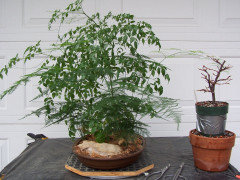
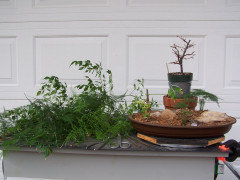
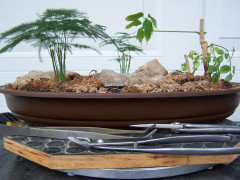
If you look closely at your planting, you'll see there is sort of a 'second canopy' lower than the top canopy. You could remove the top part by cutting back the long stems to just above a side branch, which would shorten the composition significantly; or, you could remove side branches low on the stems so you're left with a plant that grows like bald cypress or acacia .....

..... at least that's what I was after.
"my ginkgo leaves ..... has a lot yellow dots. the nearby plants also has a lot little spot on leaves like that. also, the ginkgo leaves looks a bit dry and wrinkle like a folding kongfu fan. I wonder if that's normal. what do you think? I think your plants are suffering from spider mites. Do check for scale insects and mealybug too, just to be sure one of those is not the culprit. You can get rid of mites by thoroughly spritzing the plant at 4 day intervals with 2:1 mix of water and 70% rubbing/ isopropyl alcohol (2 water: 1 alcohol). Be sure to wet the underside of the foliage and all cracks & crevices. Cover the soil while spritzing as the roots won't appreciate what the alcohol does to root (lipid) membranes.
***********************************************************************************
John said: "I have no issue repotting it, I just felt it might not be the best use of my time as opposed to just letting it continue to grow as it doesn't seem distressed or in dire need of a repot. Maybe I took too much for granted, and your plant doesn't need repotting, John. If the root/soil mass can be lifted from the pot as a unit/ intact, the plant would definitely benefit from a repot. If soil crumbles away from the root mass, you could wait until next June. I'm not sure what I would repot it into - would it be more proactive to move it into a more bonsai style pot or would it not matter at this point. Basically could I pot it into a standard black plastic nursery pot? Does it matter too much? ..... doesn't really matter much what sort of pot it's in as long as the roots have plenty of room.My suggestion would be to repot it into a terra cotta bulb pan, using a very fast-draining medium, and fertilize regularly. The bulb pan allows the medium to dry faster. You could even use a pond basket. Lots of aeration, frequent fertilizing, and plenty of sun + air movement will really speed development. The tree below has 7 sacrifice branches that are thickening the trunk and adding taper. See the 'top' of the trunk with the wire on it - about even with the knot in the plywood? Next spring, I'll set the pond basket on a raised bed so the roots can run into the ground. I should be able to thicken the tree by about 1" per year that way.
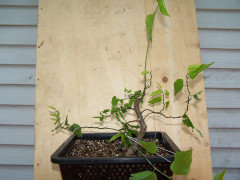
Jumping a bit ahead, the styles that draw my eye are the informal upright and the Literati. I've never seen a graphic depicting these different styles, this is so cool! Sekijo (I just did a quick image search) looks unreal! 2 of my trees:
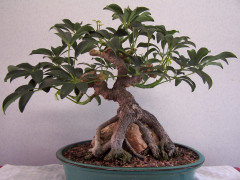
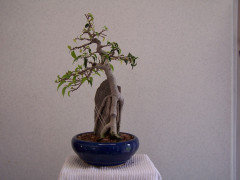
Right, back to your comments, if I were to go ahead with your recommendation and chop all of the mass above the lowest branch on the left (that is what you suggested, correct?) No, it isn't. What you now consider to be the 'trunk' will be used as a sacrifice branch to thicken the trunk below the first branch moving to the left. You'll remove some branches from what you now consider to be the tree's trunk so they will not shade the part you'll be using. Compare your tree to this:
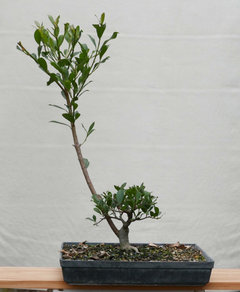
The part you view as the trunk now, will serve the same purpose as the large (sacrifice) branch on the tree immediately above. Your tree will remain largely intact with the exception of 1 pruning cut to the low left branch, and removing some low branches on the current trunk.
do I need any specific tools to do so other than a basic pair of bypass pruners? No, the Portulacaria tissue is quite soft and succulent. Any type of scissors will work until the plant starts to get woody. I don't really have anything that is a standard bonsai tool, so I'll have to use what I have or jerry-rig something. And would it be a straight cut or should it be an angled cut? Portulacaria will die back to the first node proximal (toward the roots) to any pruning cut. In 6 months or so, you'll be able to easily remove the dead tissue sort of like a scab. For other trees, you would want to make a concave cut so when the callus tissue rolls over the wound, the healed wound is flush with the rest of the bark. For that, one or both of these tools would be helpful.
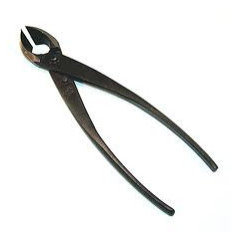
Concave cutter ^^^
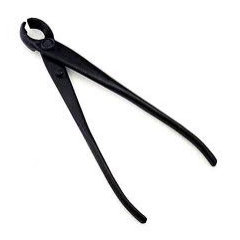
Knob cutter ^^^
Al
jasmine UKzone9a
2 years agothank you Al for all the suggestion. I am going to try work on them and see how it goes.
tapla (mid-Michigan, USDA z5b-6a) thanked jasmine UKzone9atapla (mid-Michigan, USDA z5b-6a)
Original Author2 years agoYou're very welcome. If there is anything you don't understand, please don't be shy about asking for clarification.
Al
jasmine UKzone9a
2 years agofrom your previous post about asparagus setaceus. I get the inspired to shape them in clear layers. either top down layers or left right layers. I think it looks good this way. I am not sure that's what you suggest though. I cut down the top part and tidy up the edge and make it looks like two "umbrellas". I am thinking when the plant grow taller I can make a third umbrella ( I am not sure yet, I may just keep two umbrella(layers)." I run into a small problem though. the front of the top layer is a bit messy because the leaves (feathers) grows on "wrong" direction. I am not sure if I should cut it or let it grows taller to make a third layer. here are some picture of the new look.
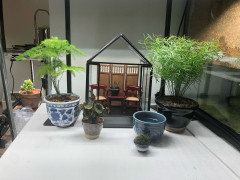
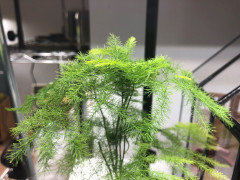
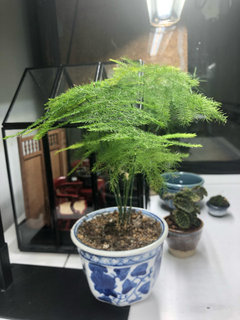
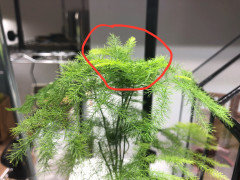
tapla (mid-Michigan, USDA z5b-6a)
Original Author2 years agoWhere the foliage is messy, start by removing 'branches' that grow back toward the center of the clump. You can also thin branches so light to lower branches isn't blocked by upper branches. That should go a long way toward cleaning up the parts that look messy.
Some hobby growers never get beyond the commonly held sense that all growth put on by the plant is sacrosanct and as such should not be removed for any reason except death. Pruning plants is an important part of increasing the enjoyment we garner from the growing experience. As long as the plant is reasonably healthy, removing plant parts that spoil the plant's eye appeal should leave us feeling better for steps made to improve the plant's appearance instead of guilty.
Al
jasmine UKzone9a
2 years agoI cut off the leaves that grow toward the center and cut out those sticking out on the top. it looks a little better now. I am really hesitated to cut my bonsai. cause I am worried if I make a wrong decision of where to cut. I may ruin the whole shape. I also don't understand how people keep such tiny tree outdoor. what if the trees fall down and break half of the tree.
tapla (mid-Michigan, USDA z5b-6a)
Original Author2 years agoI am really hesitated to cut my bonsai. cause I am worried if I make a wrong decision of where to cut. I may ruin the whole shape. I understand and wouldn't want you to do something you're not comfortable with. I also don't understand how people keep such tiny tree outdoor. what if the trees fall down and break half of the tree. I have more than 200 trees growing as bonsai or potential bonsai. All are outdoors on grow benches. I occasionally have squirrel issues, and have battled 'possums and 'coons that have knocked trees from the benches, but the biggest concern is large hail and/or wind. Sometimes trees not carefully secured will get knocked from the benches, but damage is usually minimal as the trees are secured to the pot. Thick branches that are an important part of the composition almost never break. When small branches break it's easy to grow another and wire it into position - something to be taken in stride.
Best luck with your trees. I hope you fare well.
Al
John (Zone 5b/6a, IN)
2 years agoHi there, sorry I've been MIA, but I did find time to repot the P. afra and wanted to share the update and ask for some more advice. Unsurprisingly Al, you were right, the plant was overdue for a repot. I tried to take as many photos as I could to show the current condition of the plant. Some may be redundant, but I would rather that be the case than giving an incomplete representation.
Here is the plant prior to bare rooting it. I didn't think to measure it exactly, but hopefully this gives a rough idea based on context. The bulb pan on the right is the pot that I planted the portulacaria into. I believe it is around 6" across.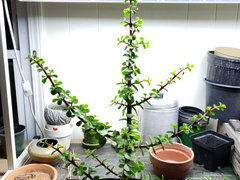
Here's a photo of it with the soil still intact. I'm happy with the roots, but less happy with whatever growth potential I may have missed out on due to not making time to pay attention to this plant earlier. Oh well, I'm just going to blame the 11-month old, definitely her fault.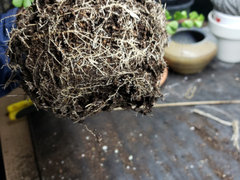
And here are a couple of shots of it bare rooted.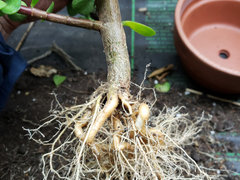
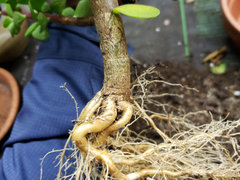
Briefly I'd like to walk through my observations and reasoning for taking the course of action that I did. Overall I see around 5 large roots and a good amount of fine roots. As a general rule I've learned that the large roots function more to provide structural stability for the plant while the fine roots actually do more of the heavy lifting when it comes to uptaking water and nutrients for the rest of the plant to use.
So keeping that in mind I would think that it would be in my, and the plant's, best interest to prune the large roots away and trim up some of the fine roots to stimulate further fine root growth. However, that isn't exactly what I decided to do for the following reasons. Something I've seen in other bonsai specimens is large roots that are able to be seen above the soil line, at the base of the plant. I've seen the term 'nebari' thrown around but I'm not sure what it means (it's tugging at a part of my brain that's saying it's relevant, but maybe it's not). I'll also completely admit that I haven't done my due diligence here and looked anything up. Regardless, I left some of the larger roots because I thought they have the potential to become important design elements as the tree comes into its own. For all I know this may be wrong or end up inhibiting plant the growth, but that's a lesson I guess I'll have to learn. I don't have a fleshed out vision for this tree yet, but the classic informal style appeals to me very much.
So, as seen in the 2nd photo above, there is a cluster of large roots stacked almost right next to each other. When I was bare rooting the plant they were more or less stuck to each other and I was wondering if there was a potential for issues with girdling/root constriction in the future if they were left as they were. What I decided to do was take out the large root on the right, and one other larger root on the backside, along with cleaning up about 1/3-1/2 of the fine roots. Photos below. Unfortunately I didn't replicate my point of view from the second photo above, but I hope this shows it well enough to demonstrate a before/after.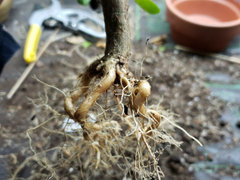
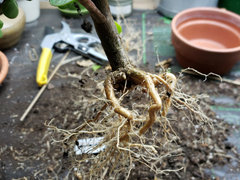
After this, I thought I was ready to replant it into its new pot and proceeded to do just that only to realize I had not prepared any wire or had a way to stabilize the plant. The only wire I had around was a leftover spool of galvanized steel(?) that's commonly used for electric fencing around pens. I think it was 1/16" wire. It wasn't the easiest to bend but it was all I had. Poor planning on my part really bit me here. I had to leave the plant bare-rooted for about 20 extra minutes while I got the wire cut and placed; I'm hoping the forgiving nature of P. afra will keep the plant from suffering too much due to this delay. Unfortunately the wiring attempt I made didn't hold the plant all the way in place so I used a bamboo skewer to lean it against until I have time to get a different type of wire and try again.
At this point it was getting quite late so I don't have any more photos, but all I did after this was make 1 pruning cut to the lower left branch (think we got on the same page about this in a previous post) and had to pack it in for the night. I'm a bit concerned about the difference between root and branch pruning as I understand it's less stressful on the plant if you keep a rough balance between your above/below ground pruning. Have I made a massive error here or something marginal that I could correct this evening?
The plant is back outside in an area that is shaded for most of the day and was planted into a dry 1-1-1 mix of pine bark, washed manna pro poultry grit, and washed SafeT Sorb. I'll be taking a photo of it this evening hopefully so I can ask more specific styling/pruning questions. Is there anything you'd recommend based on what I've done so far? I was planning on waiting to water it, but I'm not sure how long to wait. For context I'm in west-central Indiana, zone 5b/6a. Thanks in advance for any input/advice.
Jtapla (mid-Michigan, USDA z5b-6a) thanked John (Zone 5b/6a, IN)RoseMe SD
2 years ago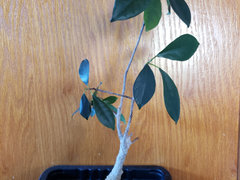
I found this bonsai that I have neglected for over six years on top.of my refrigerator.
Not sure: 1) what is its name, 2) how to help it grow better, 3) what is it supposed to look like when in excellent care.
What I do know: 1) it gets water rarely maybe once or twice a month, 2) it doesn't like sun not even indirect sun. 3) it is a miracle that it is still alive.tapla (mid-Michigan, USDA z5b-6a)
Original Author2 years agoJohn - I spent about 1.5 hrs earlier putting together a reply to your post. My reward was a notice from Houzz, out of the blue, that "Something Went Wrong. Please try again later" The frustration was a little to much, so I'll try again tomo if I can be free long enough. There was a lot to say.
Rose - your tree is Ficus retusa (commonly ginseng Ficus)
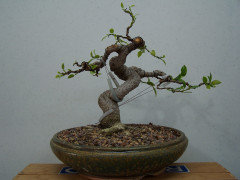
This ^^^ is a very close cousin of your tree that has just been pruned very hard and wired. See another pruned wired and partially defoliated to force back-budding.
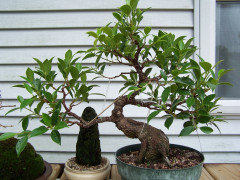
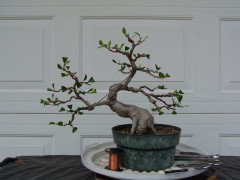
Your tree needs repotting into an appropriate medium, a spot outdoors until temps drop below 55*, and regular applications of fertilizer. Do that, and I guarantee you'll be amazed at the speed of the recovery. ALL my ficus are in full sun. You'll need to put yours in the shade until it responds. Suggestions step by step
1) Flush the soil. Water with room temperature water until the soil is completely saturated. Allow the planting to rest for 15 minutes to an hour to allow as much of the salt accumulation as possible to go into solution, then pour a volume of room temp water equal to at least 10X the volume of the pot the plant is in slowly through the soil. This will remove most of any accumulation of offending salts and resolve any skewing of nutrient ratios.
2) After flushing the soil, add a handful of moist potting soil mixed with an equal volume of perlite
3) fertilize the plant with a production dose of Foliage-Pro 9-3-6
4) Move the plant outdoors to open shade or dappled shade beneath a shade tree.
5) When you see the tree back-budding - repot it. Don't delay as it's getting very late in the growth cycle to repot a tree in steep decline. Where did you say you live?
6) Use the tell to determine when the tree needs water.
Questions?
Al
RoseMe SD
2 years agolast modified: 2 years agoPlease see my questions below:
1) Flush the soil.
# yes I can.
2) After flushing the soil, add a handful of moist potting soil mixed with an equal volume of perlite
# there isn't enough room in the pot to add much more soil in though.
3) fertilize the plant with a production dose of Foliage-Pro 9-3-6
# yes to that.
4) Move the plant outdoors to open shade or dappled shade beneath a shade tree.
# I am not sure this plant of mine likes sun. When I had it next to kitchen window before, all leaves turned yellow and fell no matter if I water it or not.
5) When you see the tree back-budding - repot it. Don't delay as it's getting very late in the growth cycle to repot a tree in steep decline. Where did you say you live?
# San diego. What does "back budding" mean? Do I prune anything off now? How much water, how frequently, does it need?
6) Use the tell to determine when the tree needs water. # no room for a tell in the pot.
John (Zone 5b/6a, IN)
2 years agoAl,
That's the worst and I'm so sorry to hear that it happened. I'm really grateful that you would take that much time and effort in the first place. I've taken to writing most of my lengthier posts in word/notepad/onenote because I hate having that occur.
I don't have much I'm working on currently, just trying to downsize mostly (no grow lights and winter is approaching quickly).
My wife has two umbrella trees she no longer wants and I realized recently they might make good candidates for bonsai practice if I hang on to them. Photos below - thoughts?
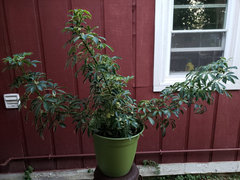
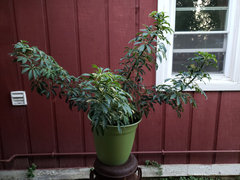
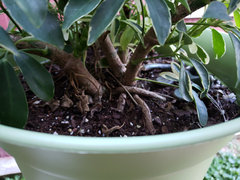
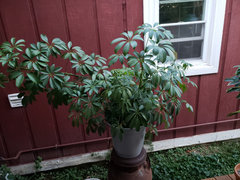
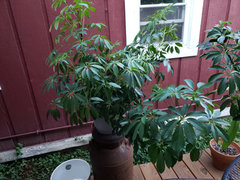
tapla (mid-Michigan, USDA z5b-6a)
Original Author2 years agoI'm happy with the roots, but less happy with whatever growth potential I may have missed out on due to not making time to pay attention to this plant earlier. Don't be too upset or hard on yourself. The root congestion shown in the image is actually quite mild, so you didn't lose much potential. Something I've seen in other bonsai specimens is large roots that are able to be seen above the soil line .... I've seen the term 'nebari' thrown around but I'm not sure what it means .... Regardless, I left some of the larger roots because I thought they have the potential to become important design elements as the tree comes into its own. You did well to leave them. Good nebari/ surface roots are an important consideration for all bonsai, and practitioners regularly start cuttings from parent trees and use them for root grafts on trees that lake roots in strategic places. The tree you see below, started from a cutting, has spectacular nebari. I drilled a hole in a piece of Lexan (plastic) and threaded the cutting through the hole, then planted the cutting. As the cutting grew, the Lexan girdled it, creating a dam to the flow of nutrients and auxin to the roots. This resulted in roots growing immediately above the plastic and radiating horizontally from the trunk.
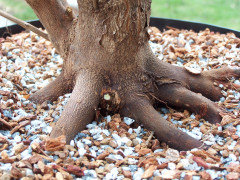
So, as seen in the 2nd photo above, there is a cluster of large roots stacked almost right next to each other. When I was bare rooting the plant they were more or less stuck to each other and I was wondering if there was a potential for issues with girdling/root constriction in the future if they were left as they were. No, there wouldn't be. What I decided to do was take out the large root on the right, and one other larger root on the backside, along with cleaning up about 1/3-1/2 of the fine roots. At some point, redundant roots need to be removed by cutting where they attach to the trunk, and better now than later, as long as you have a sense the tree will tolerate it.
After this, I thought I was ready to replant it into its new pot and proceeded to do just that only to realize I had not prepared any wire or had a way to stabilize the plant. The only wire I had around was a leftover spool of galvanized steel(?) that's commonly used for electric fencing around pens. I think it was 1/16" wire. It wasn't the easiest to bend but it was all I had. Poor planning on my part really bit me here. I had to leave the plant bare-rooted for about 20 extra minutes while I got the wire cut and placed; I'm hoping the forgiving nature of P. afra will keep the plant from suffering too much due to this delay. Unfortunately the wiring attempt I made didn't hold the plant all the way in place so I used a bamboo skewer to lean it against until I have time to get a different type of wire and try again. I don't worry about keeping the roots of succulents wet while I repot them. In fact, I usually wait several days before I start supplying any moisture to the plant. I repotted a Fockea edulis about a week ago, and the first waterit received was during a heavy storm we suffered Tuesday, so 5-6 days in a dry medium can be considered good practice for most succulents.
At this point it was getting quite late so I don't have any more photos, but all I did after this was make 1 pruning cut to the lower left branch (think we got on the same page about this in a previous post) and had to pack it in for the night. I'm a bit concerned about the difference between root and branch pruning as I understand it's less stressful on the plant if you keep a rough balance between your above/below ground pruning. Have I made a massive error here or something marginal that I could correct this evening? Portulacaria and most succulents are pretty forgiving of imbalance in the root:shoot ratio, so I don't think it will be a problem. It is time to be thinking about positioning a low branch as the future trunk, though. It's better to plan ahead and preposition the future trunk while branches are flexible. With some trees, like hackberry and boxwood, it's essential to do all wiring while branches are very young; this because some species are known for having branches that lignify very quickly and become so hard to bent that breakage is a big concern. You can tie the lowest branch to the main trunk and add some movement to it whenever you get the chance, if you like. Also, I'm imagining you'll want to change the planting angle at the next repot. The trunk should leave the soil at an angle for an informal upright style. It would also make the use of the low branch as the future trunk more believable.
My wife has two umbrella trees she no longer wants and I realized recently they might make good candidates for bonsai practice if I hang on to them ...... thoughts? Those have a nice, compact growth habit and will make good bonsai. Make sure she doesn't see them after you prune them because she's gonna want 'em back!
Al
jasmine UKzone9a
2 years agorecently I am working on my jasmine sambac plant. I like the look of your lavender star flower. even there are so much branches there, but they all grow in good locations and match well with each other. what are your rules of cutting and relocated branches? I know I should cut off cross branches, or two branches goes on same direction is not good. what else?
here are two photos of my jasmine. I have been thinking of a long time if I should cut off the biggest branch that comes up from soil on the left side. 1.if I keep it. the whole bush will looks wider and more full growth, more branches. 2.if I cut it, the trunk stand alone may seems a bit odd? I am not sure though. 3. if I keep it. I don't know where should it grows branches to match well with the main trunk. because I don't know what to do with this big branch. I cut off many new branches to try to create a good shape but it doesn't seems so successful. this is my most beloved jasmine plant. it gives a lot yummy scent jasmine flower from early spring to late summer. I wish it can grows in better shape as well.
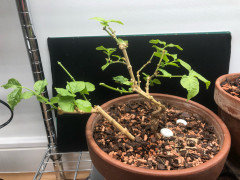
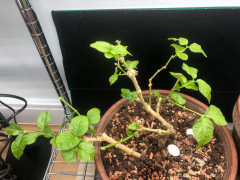
RoseMe SD
2 years agoI am working on getting my young michelia Alba to produce more flowers, but instead, I get baby foliages. Aren't they cute though ὠ2?
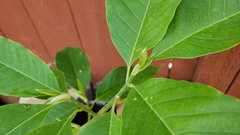
RoseMe SD
2 years agoTotally forgot this us Bonsai forum, sorry. Well my ginger bonsai is growing too....
Any advice on where and how to prune this thing?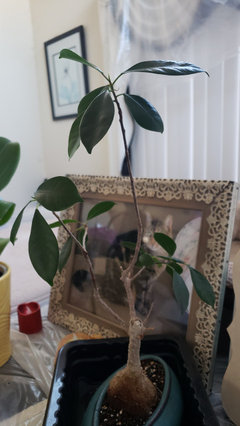
tapla (mid-Michigan, USDA z5b-6a)
Original Author2 years agoWeilin & Rose ......
"..... what are your rules of cutting and relocating [positioning] branches?" There is a set of rules regarding tree ht in relation to trunk diameter, pot size, branch placement that if followed will produce a proportional and aesthetically pleasing tree, but nothing is carved in stone. Some trees break all the rules and still manage to look spectacular. I think new bonsai practitioners receive a pearl of wisdom when told it's best to know the rules before you break them, and the longer you practice bonsai the more comfortable you become with breaking them, but only when you've become practiced enough to be comfortable allowing your eye for esthetics to overrule the "rules" re what makes a good bonsai.
* Planning ahead by wiring your tree's trunk/ branches while still young is important. Not all trees have branches that bend easily when they are wired, but almost all branches can easily be wired when young.
* Except for trunks of trees grown in the formal upright style
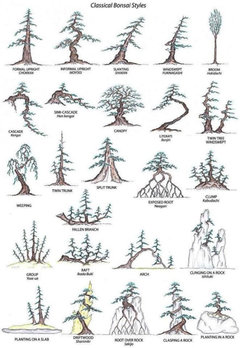
try to avoid straight trunks and branches. Branch movement (form) should be described as sinuous, moving in all directions - think of an elongated irregular corkscrew. the amount of movement in the branches should mimic the amount of movement in the trunk. If you're building a tree with trunk movement like you see in the Japanese maple below, straight branches or branches with only slight movement will look out of place.
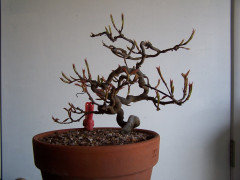
* In nature, you most often see trees with branches growing on the outside of a curve. Take note of how the branches are positioned in the chart of 'bonsai styles' in this post.
* Usually, the front view of your tree/ composition is determined by what angle provides the most attractive view of the nebari (roots). Once the front is determined, you'll need to position branches (most styles) so the tree welcomes you in with open arms.
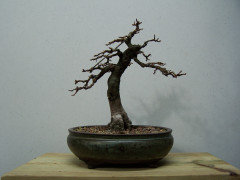
* You can't see it in a 2D image, but the 2 lowest branches on this Korean hornbeam are like an open pair of arms about to give you a hug, and the apex/ top of the tree is politely bowing toward you in greeting. Notice how I positioned all branches on the outside of a curve except for the pocket branch on the right which provides the tree with visual balance.
* Learn to use 'sacrifice' branches.
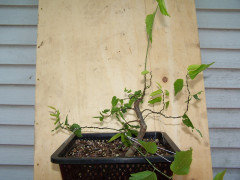
This is a very young hackberry tree (2.5 years) from seed, and the image was taken just after its first wiring. It has at least 5 sacrifice branches, the only purposes of which are to A) create additional energy so the tree develops/ grows faster and B) to thicken the trunk.
They are wired flat for a distance from the trunk, then turned upward at a 90* angle. That arrangement serves to A) prevent the sacrifice branches from shading out the branches that WILL be a part of the end composition, and B) branches growing vertically instead of horizontally get a much larger share of the energy/ food produced during photosynthesis, which means the branches planned as part of the composition will grow smaller, which means the leaves on those branches will be smaller and internodes shorter.
"...... here are two photos of my jasmine. I have been thinking of a long time if I should cut off the biggest branch that comes up from soil on the left side. 1.if I keep it. the whole bush will looks wider and more full growth, more branches. 2.if I cut it, the trunk stand alone may seems a bit odd? I am not sure though. 3. if I keep it. I don't know where should it grows branches to match well with the main trunk. because I don't know what to do with this big branch." Try to avoid pruning after Aug 1 because the tree is storing energy that will help it get through the winter, and removing branches with foliage limits the amount of food/ energy the plant can create. Also, it's counter-productive in the sense that the growth put on during the winter will be long/lanky, something you don't want to retain as part of the composition. It's better to get into a rhythm of pruning hard in June. That way, you will be removing all the elongated rank growth, and retaining the tight growth the plant puts on during the summer months.
*********************************************************************
Any advice on where and how to prune this thing? While images of your tree look better than the last images I saw, it still hasn't recovered to the degree I could suggest you do any pruning at all. Best to be patient and wait until next June to prune it, assuming the recovery keeps progressing. From the perspective of its well being, it's going to need all its food factories (leaves) to make it through the winter; and, from the perspective of esthetics, the same thing I said to Weilin applies: Pruning now would be counterproductive in the sense that the growth put on during the winter will be long/lanky, something you don't want to retain as part of the composition. It's better to get into a rhythm of pruning hard in June. That way, you will be removing all the elongated rank growth, and retaining the tight growth the plant puts on during the summer months.
Al
RoseMe SD
2 years ago@tapla (mid-Michigan, USDA z5b-6a)
Thank you so much for sharing expert opinion. I won't touch the baby foliages of course but is it safe to cut off these small and thin branches that don't look alive anyways?
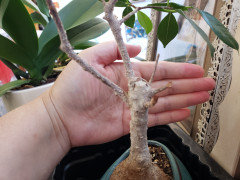
tapla (mid-Michigan, USDA z5b-6a)
Original Author2 years agoThey can be removed with no forfeiture of any of your plant's growth potential.
Al
jasmine UKzone9a
2 years agolast modified: 2 years agoThank you for reply. There are a lot new knowledge in your comments. I am still trying to understand them. You said:
"Usually, the front view of your tree/ composition is determined by what angle provides the most attractive view of the nebari (roots).”
I understand to choose the most attractive view to be the front. but most attractive view of the nebari (surface root)? I think most bonsai, especially young bonsai, don't have surface root yet. it took long time to create them. so I don't understand how to choose a front view base on that. I think I misunderstand you here. what do you think about the view I show on photo below? is it ok?
"Learn to use 'sacrifice' branches.”
Base on my understand. I should wire and bend those undesired branches horizontally and let it grow far away from the composition. So in my situation. Those two branches with Red Cross on photo below are too close to the main trunk. I should bend them down or simply remove them? I should make sure all branches grow on the woody sacrifice branch on left will grow horizontally and far away from branches on main trunk?
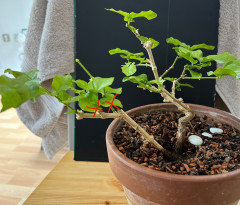
"wiring your tree's trunk/ branches while still young is important. “My jasmine is an evergreen vine shrub. So, I should wire it anytime through the year? Because there is always new branch grow on those woody stem. I don’t want to hurt them. So I had think about to wire my jasmine at winter when it grows slow. but maybe put wire on when branches are young are more important?
About how to wire bonsai. Do you put wire on every branch first and decide how to move them later? My jasmine seems to be very close to informal upright style. Maybe I should search more about informal upright bonsai and try to make mine that way.
"branches growing on the outside of a curve”
On your Korean hornbeam and trees on the chart, branches grow on where the curve “pointed” at and also most branches grow on the same side on that direction too. Like your Korean hornbeam. All the curve of the big branches point upward. So most of the smaller branches grow on upper side of the big branches as well. You have fewer branch point down. I think those are just to create the balance look?
"try to avoid straight trunks and branches. Branch movement (form) should be described as sinuous, moving in all directions - think of an elongated irregular corkscrew. the amount of movement in the branches should mimic the amount of movement in the trunk.”
I am not sure I totally understand this concept. It’s a bit abstracted to me. But I may have some clues. Your Korean hornbeam’s trunk is slightly bended. So all the branches are slightly bend as well. Your Japanese maple trunk bend and twist crazily. All the branches around it bend and twist crazily as well and you said it will be odd to have straight branch on it. I agree.
I think I have a little clue of how to shape my jasmine now. Thank you for helping me with that. There is one more thing about this jasmine confuse me for a long time. Could you give me suggestion as well. As you see on the leaves at photo below. A lot of them grows in a weird shape. They should be flat as a paper. But grow in a 3D shape. Do you know what maybe the reason?
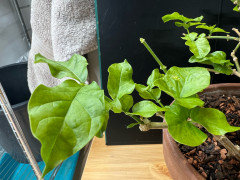
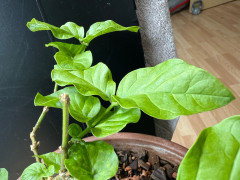
jasmine UKzone9a
2 years agomy scot pine bonsai looks a bit messy. I wonder if I should cut those pine needle shorter and remove some of them. does anyone know when should I repot it? I have it for 2 years. I never repot it. I see some root near the drainage hole but they didn't grow out the drainage hole.
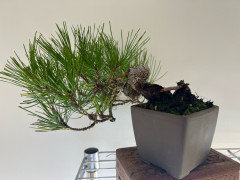
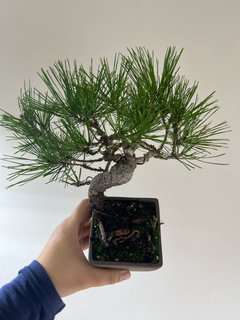
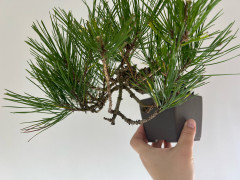
tapla (mid-Michigan, USDA z5b-6a)
Original Authorlast yearlast modified: last yearToday I did a major pruning and some minor rearranging of branches on this zelcova I grew from a cutting. It was grown on in the raised beds I use for that purpose and lifted in spring of '20.
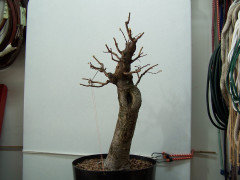
I'm thinking it will get a pot next spring.
Al
tapla (mid-Michigan, USDA z5b-6a)
Original Authorlast yearlast modified: last yearFirst pruning of hackberry trees from seed; plus, and an air layer established
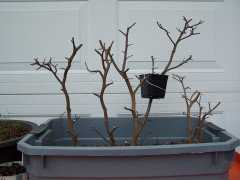
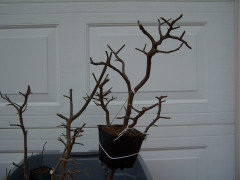
... a better look at the air layer ^^^Acer campestre 'Compacta':
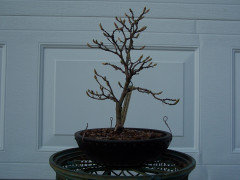
Pseudocydonia sinensis (Chinese Quince). I'll prune, dewire, and rewire it today in the garage. Too cold outdoors to do fine work which requires nimble fingers today: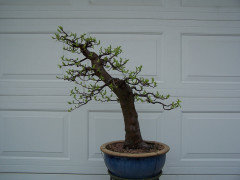
The trunk is about 1.5X the diameter of a soda/beer can.
Al
tapla (mid-Michigan, USDA z5b-6a)
Original Authorlast yearPotentilla fruticosa - Images taken a year apart, confirming that small pots definitely slow development
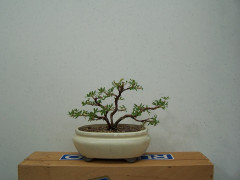
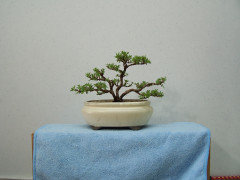
Al
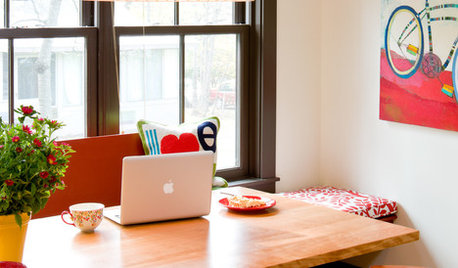


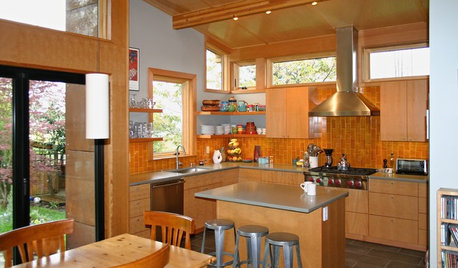

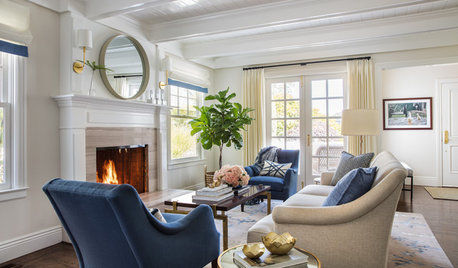
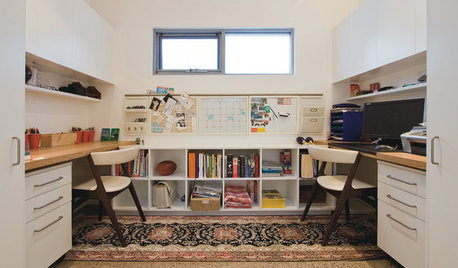

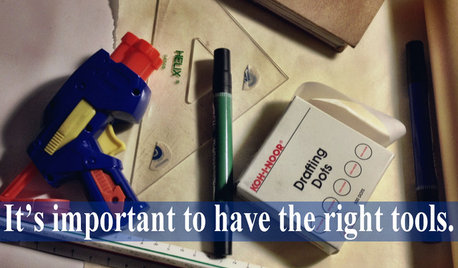






tapla (mid-Michigan, USDA z5b-6a)Original Author